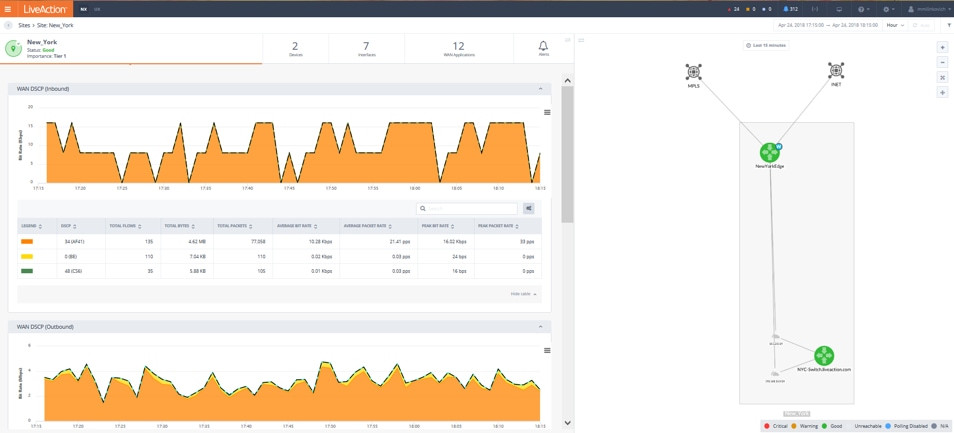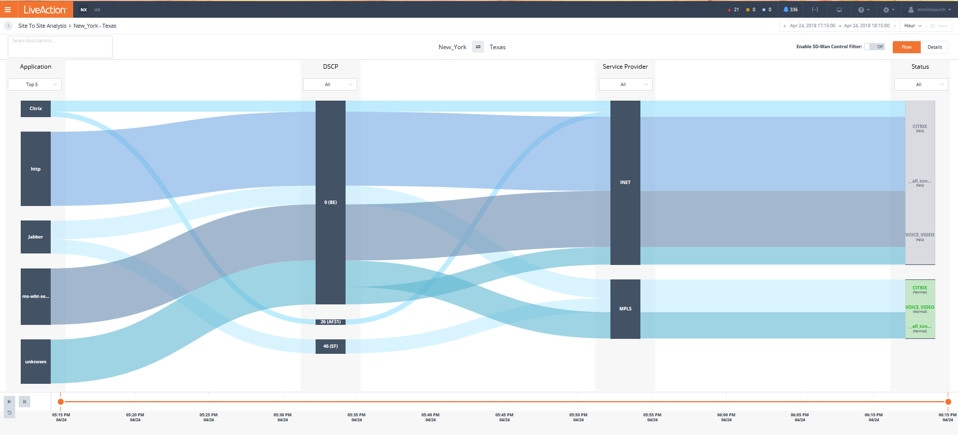Network Performance Management and Analytics are Key to SD-WAN Success
Mark Milinkovich, LiveAction
SD-WAN adoption is on the rise. Cisco’s Virtual Network Index (VNI) predicts SD-WAN traffic will grow at a CAGR of 44 percent through 2021, compared to five percent for traditional WAN. Meanwhile, networks continue to get more complex. Consider the EMA Research report, “Advanced Network Analytics: The Future of Network Engineering and Operations,” that found network managers spend nearly 71 percent of their time fixing problems. EMA analysts predict “this situation will only get worse as networks get more complex and enterprises adopt new solutions, such as software defined networking (SDN), software-defined WAN (SD-WAN), the Internet of Things, network virtualization, software-defined data centers (SDDC), and public and hybrid clouds.”
The strategic benefits of SD-WAN are well known – higher ROI, less downtime, greater security – putting the shift to software defined networks at the top of the CIO’s priority list. To fully realize those benefits, businesses are looking to simplify the management of complex networks. And network engineers are turning to network performance management platforms (NPM) that offer comprehensive visualization and analytics.
Driving greater demand for complete visibility, analytics and assurance is the reality drive by today’s enterprise network consists of a hybrid and multi-platform network environment. This makes adopting multi-fabric SDN technologies challenging, especially when it comes to verifying and understanding application traffic behavior. For these reasons, apply a “Day 0, Day 1 and Day 2” NPM lifecycle framework to SD-WAN design and deployment.
Day 0 – In the initial assessment phase, the architecture team captures the current state environment to baseline the application requirements from the network in terms of bandwidth, response time, delay/latency and packet loss. To accelerate this stage, automate the discovery of devices, applications and logical and physical network topologies. This baseline is critical to designing policies for application path routes and service provider transport SLAs. Also during this phase, end user requirements such as top talkers, top applications, App Group types, SLA classes, and transport behaviors are best captured in site-to-site views because it highlights design requirement for proof of concept (POC) testing. This results in more effective deployment planning and rationalization.

Day 1 – Visual Verification: As the project moves from architecture design to POC to a production environment, it’s critical to be able to visualize the entire network. This includes showing inter-site flows and correlating application data with flow on edge devices for rich application details such as transport paths, usage, and performance. Visual verification also helps validate the policy/intent is operating as expected across applications, the fabric, tunnel overlays, and the service provider’s preferred paths per site. This phase of the project is where the application and site-specific designs are rapidly validated to ensure service provider transport is delivering the designed Quality of Experience (QoE), efficiency and cost benefits.
By seeing multiple data sets (MDS) aggregated into a single graph, such as a Cisco SD-WAN Topology view, the path and service provider performance are presented together. Visual analytics such as Sankey or Chord diagrams, or active topology maps with NetFlow, SNMP and REST API, correlate data for a precise view of the policy implementation provide drill downs for further trouble shooting if necessary.

Day 2 – Hybrid Network Management. This stage is defined as a gradual transition from the old to the new in a controlled way. Typically, the initial migration from POC to production is a subset of the entire enterprise, usually lower risk with more tolerant end users. It also means there is a mix of legacy and new in a hybrid operational environment, requiring systems and IT processes accommodate both. Supporting the hybrid network environment requires networking professionals view service assurance as an ongoing job to ensure continuous improvement and adoption of best practices.
This is where advanced visualization and analytics of network performance across the entire enterprise accelerates and validates SD-WAN ROI. It does this through proactive notification of anomalous behavior such as routing black holes, voice or video data being incorrectly routed as “Best Effort” and across the incorrect transport service, and countless other examples. Network performance management solves for faster remediation of incidents through comprehensive troubleshooting workflows and integration with IT service management (ITSM) systems for automated incident management.
As companies invest in SD-WAN and networks get even more complex, network engineers require a more comprehensive view across the entire network. With network performance management and analytics that complement SD-WAN technologies, including IWAN, Meraki and Viptela, businesses are well positioned for the rise in SD-WAN traffic while network engineers can significantly reduce the time spent fixing problems.
